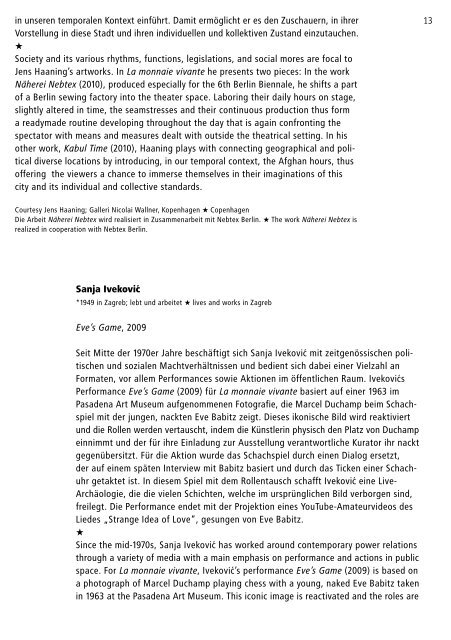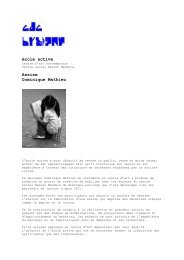Die 6. Berlin Biennale für zeitgenössische Kunst ... - CAC Brétigny
Die 6. Berlin Biennale für zeitgenössische Kunst ... - CAC Brétigny
Die 6. Berlin Biennale für zeitgenössische Kunst ... - CAC Brétigny
Erfolgreiche ePaper selbst erstellen
Machen Sie aus Ihren PDF Publikationen ein blätterbares Flipbook mit unserer einzigartigen Google optimierten e-Paper Software.
in unseren temporalen Kontext einführt. Damit ermöglicht er es den Zuschauern, in ihrer<br />
Vorstellung in diese Stadt und ihren individuellen und kollektiven Zustand einzutauchen.<br />
★<br />
Society and its various rhythms, functions, legislations, and social mores are focal to<br />
Jens Haaning’s artworks. In La monnaie vivante he presents two pieces: In the work<br />
Näherei Nebtex (2010), produced especially for the 6th <strong>Berlin</strong> <strong>Biennale</strong>, he shifts a part<br />
of a <strong>Berlin</strong> sewing factory into the theater space. Laboring their daily hours on stage,<br />
slightly altered in time, the seamstresses and their continuous production thus form<br />
a readymade routine developing throughout the day that is again confronting the<br />
spectator with means and measures dealt with outside the theatrical setting. In his<br />
other work, Kabul Time (2010), Haaning plays with connecting geographical and political<br />
diverse locations by introducing, in our temporal context, the Afghan hours, thus<br />
offering the viewers a chance to immerse themselves in their imaginations of this<br />
city and its individual and collective standards.<br />
Courtesy Jens Haaning; Galleri Nicolai Wallner, Kopenhagen ★ Copenhagen<br />
<strong>Die</strong> Arbeit Näherei Nebtex wird realisiert in Zusammenarbeit mit Nebtex <strong>Berlin</strong>. ★ The work Näherei Nebtex is<br />
realized in cooperation with Nebtex <strong>Berlin</strong>.<br />
Sanja Iveković<br />
*1949 in Zagreb; lebt und arbeitet ★ lives and works in Zagreb<br />
Eve’s Game, 2009<br />
Seit Mitte der 1970er Jahre beschäftigt sich Sanja Iveković mit <strong>zeitgenössische</strong>n politischen<br />
und sozialen Machtverhältnissen und bedient sich dabei einer Vielzahl an<br />
Formaten, vor allem Performances sowie Aktionen im öffentlichen Raum. Ivekovićs<br />
Performance Eve’s Game (2009) <strong>für</strong> La monnaie vivante basiert auf einer 1963 im<br />
Pasadena Art Museum aufgenommenen Fotografie, die Marcel Duchamp beim Schachspiel<br />
mit der jungen, nackten Eve Babitz zeigt. <strong>Die</strong>ses ikonische Bild wird reaktiviert<br />
und die Rollen werden vertauscht, indem die Künstlerin physisch den Platz von Duchamp<br />
einnimmt und der <strong>für</strong> ihre Einladung zur Ausstellung verantwortliche Kurator ihr nackt<br />
gegenübersitzt. Für die Aktion wurde das Schachspiel durch einen Dialog ersetzt,<br />
der auf einem späten Interview mit Babitz basiert und durch das Ticken einer Schachuhr<br />
getaktet ist. In diesem Spiel mit dem Rollentausch schafft Iveković eine Live-<br />
Archäologie, die die vielen Schichten, welche im ursprünglichen Bild verborgen sind,<br />
freilegt. <strong>Die</strong> Performance endet mit der Projektion eines YouTube-Amateurvideos des<br />
Liedes „Strange Idea of Love“, gesungen von Eve Babitz.<br />
★<br />
Since the mid-1970s, Sanja Iveković has worked around contemporary power relations<br />
through a variety of media with a main emphasis on performance and actions in public<br />
space. For La monnaie vivante, Iveković’s performance Eve’s Game (2009) is based on<br />
a photograph of Marcel Duchamp playing chess with a young, naked Eve Babitz taken<br />
in 1963 at the Pasadena Art Museum. This iconic image is reactivated and the roles are<br />
13




